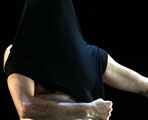Tuesday, September 11th, 2012. 8:30pm. Teatro Lope de Vega
Special 17th Bienal de Flamenco de Sevilla – All the information
Text: Estela Zatania
Photos: La Bienal
A bird in the hand and two in the bush as well
“Essentiality” is a word dancer Andrés Marín likes to use when talking about his work and objectives. He is one of the today’s greatest flamenco dance geniuses, and the one who best travels risky experimental paths without losing sight of flamenco. No matter what pranks he pulls off…and there have been many…the duendes are always on the ready waiting in the wings. The essential thing.
Maybe it’s because he bases his work on compás and cante, the umbilical cord that keeps one from getting lost in the overdose of conceptual symbolism other well-intentioned works succumb to. Maybe it’s because Marín has the capacity to know just how far he can go without crossing the frontier that leaves you in a landscape foreign to flamenco…or maybe it’s just the ease with which he makes fun of things, beginning with himself. Because nowadays the pendulum of flamenco taste is situated at the diametrically opposed pole of colorful polkadots and long sweaty hair. Today’s aesthetic is blackness, the absence of color and faces with no hint of emotion. To be sure, this work of Marín’s, “Tuétano”, is dark, in the sense of very little lighting, the wardrobe is strictly black and Marín’s face is a Buster Keaton dead-pan. But four live hens and two red-hot flamenco mammas provide the perspective that keeps the show from degenerating into a post-modern conceit.
There are many admirable elements in “Tuétano” to seduce even the most traditional fan, the guy who has his little glass of red table wine down at the corner bar where they still keep track of the bill with chalk on the table-top. And that’s the miracle of Andrés Marín. That sixth sense that seldom leads him astray and allows him to explore the possibilities of flamenco always looking back over his shoulder to the past. There are also some tedious elements, like the long recitations that can barely be heard, however, these are but small pebbles on the highway of Marín’s luminous intelligence.
That same intelligence allows him to incorporate Macanita and Concha Vargas without concessions. They appear dressed in tight black leather with their hair loose, a totally “heavy” look not customary in either one, and which is reminiscent of the controversial photographs of Ruvén Afanador, but offer cante and dance that never goes out of character. It’s an ingenious way of seeing something familiar with untainted eyes…the same old flamenco you never saw before in your life, and you discover the essentiality Marín longs for.
Macanita in all her glory, the sweetly flamenco voice of molten noble metal…siguiriyas, martinete, romance, soleá, bulerías…(is it possible the “siguiriya of the cuckoo” is an allusion to the aviary that later takes center stage?). Concha Vargas, earth mother, voluminous and instinctive, is an impossible partner for Marín. And yet, the match is not only possible but extraordinary. The versatile Raúl Cantizano plays electric guitar making the most of the variety of sound effects and distortion the instrument offers, even granaína and petenera in rock version, like a kind of Andalusian Brian May caught in full inspiration…the effect is a stroke of genius.
And Andrés’ playthings… The metallic plate that covers one side of his face, an image half-way between The Phantom of the Opera and Silence of the Lambs, and the fingers of one hand tipped with metal to tap on said metal plate producing a castanet effect. The table standing on one end with a mirror on its underside which is later borne by the dancer as a cross. The black T-shirt pulled up over his head to cover his face making him into penitent and executioner.
And the hens. What can I say about the hens? What streak of madness crossed the mind of Andrés Marín when he decided to dance with hens? Two on the table, one improvising and another comfortably nesting in the top-hat the dancer dons for the occasion. That takes art, let me tell you. And art is something not in short supply in Marín who ends the work singing (extremely well) por soleá in the dark as he crawls across the floor.
Nowadays everyone’s “original”. But to be original with artistic vision, managing to put together an entertaining show that is also fascinating and provocative, with good cante and dance that feels and smells like flamenco…that’s the recipe Andrés Marín has managed to perfect in this work.
At eleven o’clock at night, in the cozy patio of the Santa Clara convent which is turning out to be such a perfect venue for enjoying cante during the Bienal, young Jesús Méndez gave his recital. With the piano of Miguel López “Lenon”, the guitar of Diego del Morao in his most traditional style, the percussion of Ané Carrasco and the palmas of Carlos Grilo, Chícharo and Manuel Salado, the singer presented his new recording, “Añoranza”. A bulerías song, malagueñas, not the Mellizo styles you hear all the time in Jerez, but of Chacón…”del convento” was especially apt given the venue…alegrías, siguiriyas and cabal, soleá apolá, taranto and jabera, tangos, fandangos naturales, bulerías and zambra. A generous offering that brought an ovation at the end.
